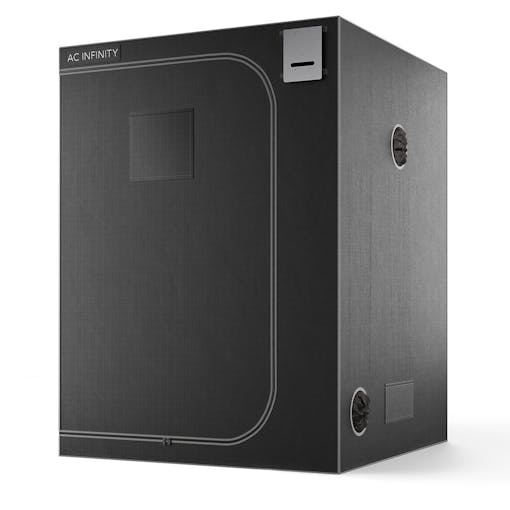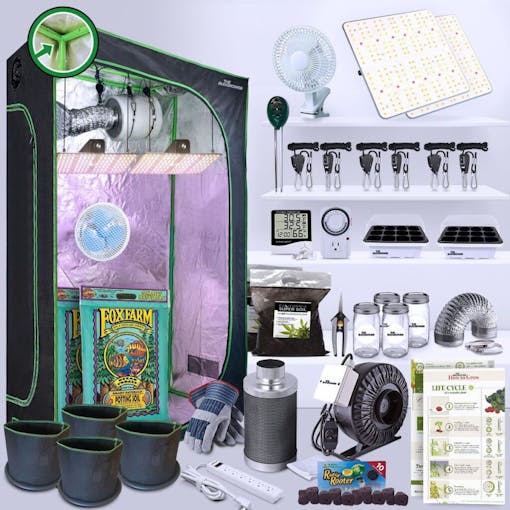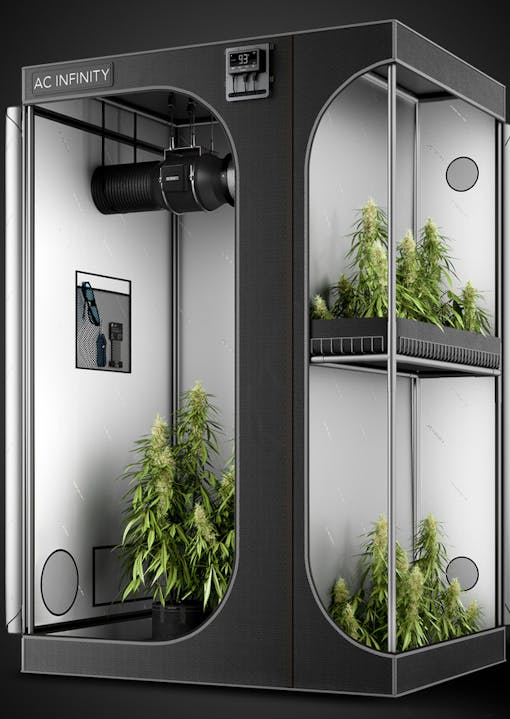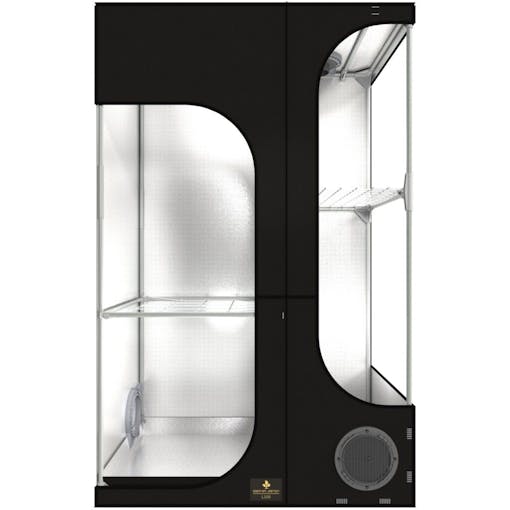Written by Matt Stangel

What is a grow tent?
Matte black on the outside and shiny on the inside, grow tents are temporary structures designed for cannabis cultivation—offering a purpose-built place to hang lights and fans without permanently modifying a residential space.
Homegrowers have flocked to grow tents for decades to minimize an indoor garden’s impact on a house while sequestering aromas, promoting plant health, and maximizing yields.
Tents come in sizes ranging just a few square feet all the way up to multi-room mini-mansions. Some are fairly basic and others are decked out in features that we’ll explore below.
Why use a grow tent?
Apart from readymade convenience, growers use tents to improve a garden’s efficiency, increase yields, and save money.
Perhaps the biggest draw is a grow tent’s ability to capture every last beam of light emitted by power-hungry horticultural fixtures: Lined with reflective materials like diamond mylar, light that would otherwise fall away from plants is sent ping-ponging between tent walls to be redistributed and absorbed across the canopy.
A comparison of common reflective materials by grow-light manufacturer MIGRO observed up to a 33% increase in canopy illumination when using industry-standard diamond mylar—that means 33% more weight come harvest time, so three ounces would become four, and an $600 ROI becomes $800.
But benefits aren’t limited to yield. Grow tents are outfitted with fan ports to swap hot, CO2-depleted air for a neutral, fresh breeze, improving a grower’s chances of raising healthy plants. Additionally, by limiting the size of a grow space, filtered exhaust fans scrub the air using far less electricity than they would in an open room—thereby minimizing a garden’s overall power consumption.
Between better yields, healthier plants, and savings on your electric bill, many hobby growers opt for a tent before building out dedicated rooms or modifying their homes.
Where to set up your grow tent

Before picking a tent, buyers should carefully consider where it will go and if that location is environmentally compatible and equipped with adequate utilities.
Temperature
For most cultivation setups, a room where a human would be comfortable in a t-shirt is perfect.
Weed plants are happiest when they’re in a temperature range of 20°F variance throughout day and night. When lights are off, temps should be no lower than 64°F during veg and 54°F during flower. When they’re on, temps shouldn’t be much higher than 84°F during either phase.
Lights add heat—HIDs more so than LEDs—but generally speaking, if the tent’s room is around 65°F, fans should be adequate to maintain a good temperature and you won’t need ACs or heaters.
Spare bedrooms usually fit the bill. Basements—cool in the summer and warm in the winter—are often well-insulated from daily weather extremes that can stress out plants. Untreated rooms are less ideal and should be avoided if possible.
For instance, garages and attics can fluctuate widely in temperature and humidity throughout the year and might not be well-suited to new growers. When raising plants in uninsulated spaces, success often rides on the use of heaters, ACs, dehumidifiers, and automated environmental control technologies that can add a lot to your utility bill.
Space for your grow tent
A cultivation room must accommodate not only the storage of a tent, but its construction. A foot or so of over-tent clearance makes for a smooth assembly, ensuring ample space to wrestle the uncompromising canvas shell over and around the frame.
To figure out how a tent sits in a room, pick a potential location and make a tape outline of the tent’s dimensions on the floor. Can people still move around in the room? Will the tent block any doors, windows, vents, light switches, or electrical outlets? If a tent needs to exhaust into the outdoors to ameliorate aroma or temp buildups, are windows or ducts available? Can plants be accessed from all necessary angles?
Safe power use
Your grow area will need to support the electrical draw of lights and fans, and potentially equipment like AC units, heaters, or dehumidifiers. If the tent setup shares a breaker with any major appliances like a dishwasher or laundry machine, you’ll need to be careful in choosing where to plug it in so as not to blow a fuse. When in doubt, use a different room.
What to look for in a grow tent
Here’s a breakdown of features to look for in a tent.
Height
A tent’s dimensions are largely dictated by a grower’s choice in lighting. HID lights run hot and need to be hung high above plants, necessitating taller tents. Conversely, LEDs run cool, hang low, and play well in a short tent.
When determining tent height, growers need to account for the type of light as well as space for an exhaust fan and carbon filter.
Frame & weight capacity
Regardless of brand, price tag, or usage, a quality tent is determined by its internal frame. Look for metal poles of a substantial gauge as well as durable corner joints. Check that a tent is able to handle the weight of gear—lights, fans, filter, and anything else you might need to suspend above plants.
Material density
Entry-level tents tend to have a fabric density—measured in D, or denier, units—around 200-600D, while top-line tent canvas maxes out between 1680-2000D. Denser fabric prevents light leaks that can trigger undesirable hormonal responses in plants. Reflective materials and additional thermal layers also contribute to a tent’s overall quality and usability.
Air exchange ports
These 6-8” ports are intended for intake and exhaust fans to keep a steady supply of fresh air moving in and out of a tent. Growers need at least two ports for an LED setup and up to four for HID lighting systems—the latter often needs two extra ports to manage the added heat from HPS or MH bulbs.
Electrical & irrigation ports
Many modern tents include 2” ports to provide a passthrough for electrical cords. Tents can become overrun with cords—the more electrical ports available, the easier it will be to keep things tidy.
If using a hydroponic system, the reservoir will likely be outside the tent, in which case, dedicated 2” irrigation ports will be needed to bring in water. The same goes for Blumline or drip systems.
Other features
Finishing touches may include:
- Zipper flaps to block potential light leaks
- Windows to check in on plants without introducing temperature or humidity fluctuations
- Floor liners or inserts to contain spills
- Tool pockets
- Gear mounts
Best flowering & all-purpose grow tents
If your goal is to use just one structure to grow weed, you’ll need a tent that can accommodate plants at their biggest, which happens during the flowering cycle, or “bloom” photoperiod.
Flowering tents are taller and wider than those intended solely for growing plants in the vegetative phase. During the first two weeks of the flowering cycle, plants will double or even triple in size depending on the cultivar and environmental conditions. Growers give themselves as much wiggle room as possible for this phase, known as “the stretch.”
Bud sites on a plant also need room to breathe. A little extra space encourages airflow between colas and helps prevent common diseases like powdery mildew and botrytis, and pests like spider mites.
Our pick for best flowering/all-purpose tent
CLOUDLAB 866 by AC Infinity ($189.99). 60” x 60” x 80”. Fabric: 2000D. Poles: 22mm steel. Weight Limit: 150lbs.

Many homegrowers use 4’ x 4’ tents for the flower cycle. That said, I personally prefer the 5’ x 5’x 6’8” CLOUDLAB 866 by AC Infinity ($189.99). The extra space promotes plant health and lets me hang side lighting just below the top of the canopy for a boost in yield.
A sturdy piece of kit, the CLOUDLAB series boasts a best-in-class 2000D canvas shell, 150-pound weight capacity, and an all-steel frame complete with 22mm poles.
In addition to standard duct ports for intake and exhaust, three air-exchange ports enable the use of a dedicated cooling system for HID light fixtures. Growers will also appreciate ample cord/irrigation ports near both the floor and ceiling, as well as on multiple walls.
The CLOUDLAB Series also has a mounting plate installed on the front for their temp- and humidity-responsive fan controller (sold separately) for smarter ventilation.
In my book, AC Infinity’s CLOUDLAB tents win out over traditional industry leaders thanks to top-quality materials, heavy-duty construction, useful touches of innovation, and a very approachable price point.
While I would like to see zipper covers to protect against light leaks, the balance of high-end features and affordability makes for one of the best value buys on the market and one of the nicest tents I’ve used, period.
Other great all-purpose tents
- Budget all-purpose tent: MAXSISUN 5’ x 5’ ($124.99). Fabric: 600D. Poles: “all metal.” Weight Limit: 120lbs.
- Variable-height all-purpose tent: ULTRA YIELD 60″ x 60″ x 84″ + 12″ Extension ($289.95). Fabric: 1680D. Poles: 22mm steel. Weight Limit: 125lbs.
- Heavy-duty, variable-height all-purpose tent: Gorilla Grow Tent 60” x 60” x 83” ($388.95) w/ 24” Extension (add $79.95). Fabric: 1680D. Poles 22mm steel. Weight Limit: 300lbs.
Best short tents
Before LED lights disrupted the homegrow market, hobbyist cultivators flowered plants primarily in tents no shorter than six feet—tall tents built to accommodate hot HID lights.
But as more homegrowers ditch HID fixtures in favor of cooler, low-hanging LED grow lights—at times requiring only inches of clearance above plants—tents no longer need to be so very tall. Thanks to the LED craze and China’s thriving OEM market, the era of affordable-yet-solid 4’ x 2’ x 5’ grow tents has arrived.
Designed for flowering plants under LEDs, these efficiency-minded, five-foot-tall tents are all over Amazon and eBay—under names like Mars Hydro, MAXSISUN, VIVOSUN, Hydrobuilder, and Spider Farmer, which have largely supplanted the leaders of yore like Gorilla Grow Tent, Lighthouse Hydro, and Secret Jardin.
Our pick for best short tent
For an à la carte short LED flowering tent, I’d go with the durable CLOUDLAB 642 by AC Infinity: 4’ x 2’ x 5’ ($109). Fabric: 2000D. Poles: 22mm steel. Weight Limit: 150lbs.

Other great short tents
TheBudGrower.com’s Dual Power Grow Kit ($995.95) is another great short tent to buy and comes complete with LED lights, fans and filters, a living-soil kit, timers, sensors, and hardware, and a 1680D-canvas tent that measures 5’ in height with a 2’ x 4’ footprint.
It does have a hefty price tag, but it’s a great kit if you don’t want to think about all the pieces involved in setting up a grow.

Ideal for an LED light, this tent is nearly identical to the Mars Hydro, VIVOSUN, and other OEM versions—consumer-pleasing tents on a race to all-time low price tags.
In addition to high-end 1680D canvas and diamond mylar reflective material, specs include 25mm steel poles and corner connectors reported to support up to 300 pounds of equipment, as well as a spill tray floor insert, dual mesh intake vents, hydro/irrigation port, electrical port, two duct ports, and three Velcro-affixed windows.
Other options include:
- Budget LED flower tent: Green Hut, 48” x 24” x 60“ ($69.99). Fabric: 600D. Poles: Steel. Weight limit: 110lbs.
- Value LED flower tent: VIVOSUN, 48” x 24” x 60“ ($99.99). Fabric: 600D. Poles: “All metal.” Weight Limit: not listed.
- Height-adjustable short tent: Gorilla Grow Tent Shorty 48” x 48” x 59-68” ($319.95). Fabric: 1680D. Poles: 19mm steel. Weight Limit: 300lbs.
Budget veg tent
Lastly, if you’re looking for a short tent to host a dedicated veg space, you can go even shorter than the tents above to ensure plants don’t get too big during the flower phase.
This CoolGrows tent, measuring 24” x 24” x 48”, is remarkably affordable at $59.99 and gets 4.6 stars over 3,000+ reviews on Amazon. The 110-pound weight capacity and 600D fabric density should be sufficient to keep plants happy for the first few months of growth. String together a few 18” T5 fluorescents for light and you’re good to get vegging.

CoolGrows 24” x 24” x 48” ($59.99). Fabric: 600D. Poles: “strong metal.” Weight Limit: 110lbs.
Other great veg tents
- High-value veg tent: CLOUDLAB 422 24″ x 24″ x 48″ ($89.99). Fabric: 2000D. Poles: 22mm steel. Weight Limit: 150lbs.
- Short veg tent: VIVOSUN 30″ x 18″ x 36″ ($75.99). Fabric: 600D. Poles: “metal.” Weight Limit: not stated.
Best multi-chamber tents (for perpetual harvesting)
Multi-chamber tents are designed to make a perpetual harvest attainable for people with a limited grow space. Perpetual harvesting allows a grower to have a fresh crop ready to harvest more frequently.
With a perpetual harvest, you can grow seedlings/clones, vegetative, and flowering plants all at the same time in different chambers, so that when you harvest the flowering plants, the veg plants will be ready to move into flower, and the seedlings/clones into veg, immediately.
In practice, this means operating multiple, self-contained chambers for vegetative and flowering plants because they require different amounts of light—18 hours of light per day for the vegetative cycle and 12 hours of light per day for flowering.
Running dedicated enclosures for each can quickly tax a homegrower’s resources. Multi-chamber tents address this, housing clones and vegetative plants in a two-level chamber and flowering plants in a second, larger compartment.
Our pick for best multi-chamber grow tent
CLOUDLAB 743D by AC Infinity. 48” x 36” x 72” ($169.99). Fabric: 2000D. Poles: 22mm steel. Weight Limit: 150lbs.

AC Infinity dominates our guide, closing with The CLOUDLAB 743D ($169.99), with a 4’ x 3’ x 6’ build, industry-leading 2000D canvas, an all-steel frame, and 150-pound weight capacity that I’ve grown to trust.
The right side situates clones at the top and veg plants on the bottom, while the flowering chamber on the left keeps the canopy low with a built-in scrog net.
While AC Infinity’s CLOUDLAB 743D is the clear frontrunner where materials, price, and overall value are concerned, Secret Jardin’s Lodge 160 ($410) is also great, but more than twice the cost. The Lodge 160’s slightly larger canopy space could make a difference when hosting so many plants in one structure. It’s 5.25’ x 4’ x 6.5’ and features M210D canvas, steel poles with polypropylene corners, and a weight limit of roughly 66 pounds.
Alternatively, growers can go even bigger with VIVOSUN’s 2-in-1, 9’ x 4’ x 7’ ($299.99)—though I’d warn against doing so without a plan for distributing the power draw across multiple dedicated breakers.

Other great best multi-chamber grow tents
- Classic multi-chamber tent: Secret Jardin’s Lodge 160 (MSRP $410) 63” x 48” x 78”. Fabric: M210D. Poles: 16mm chrome-plated. Weight Limit: ~66lbs. NOTE: plastic corner joints.
- Budget multi-chamber tent: Mars Hydro’s 36” x 24” x 55” 2-in-1 ($105.99). Fabric: 1680D. Poles: Steel. Weight Limit: 110lbs.
- Upsized multi-chamber tent: VIVOSUN’s 2-in-1 108″ x 48″ x 80″ ($299.99). Fabric: 600D. Poles: zinc-plated steel. Weight Limit: 88lbs.
Read more of Leafly’s guide to growing marijuana
- How to grow weed: Basics of growing marijuana
- 4 stages of marijuana plant growth
- Marijuana plant anatomy
- How to grow weed indoors
- How to grow marijuana outdoors
- Cannabis seeds 101: How to grow marijuana from seed
- How to clone cannabis plants
- Marijuana seedling and plant care
- How to harvest marijuana plants
- Troubleshooting common cannabis plant problems
- Buyer’s guides for cannabis seeds and growing equipment
- How to grow marijuana using hydroponics, aeroponics, or aquaponics
Ready to start growing your own marijuana?
Buy marijuana seeds on Leafly.
By providing us with your email address, you agree to Leafly's Terms of Service and Privacy Policy.